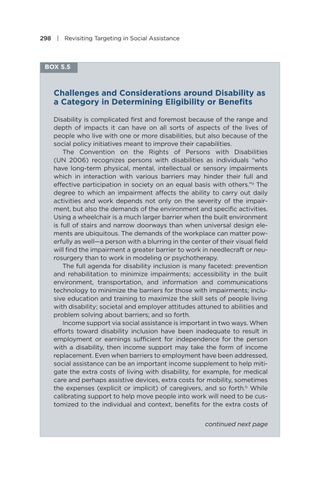298 | Revisiting Targeting in Social Assistance
BOX 5.5
Challenges and Considerations around Disability as a Category in Determining Eligibility or Benefits Disability is complicated first and foremost because of the range and depth of impacts it can have on all sorts of aspects of the lives of people who live with one or more disabilities, but also because of the social policy initiatives meant to improve their capabilities. The Convention on the Rights of Persons with Disabilities (UN 2006) recognizes persons with disabilities as individuals “who have long-term physical, mental, intellectual or sensory impairments which in interaction with various barriers may hinder their full and effective participation in society on an equal basis with others.”a The degree to which an impairment affects the ability to carry out daily activities and work depends not only on the severity of the impairment, but also the demands of the environment and specific activities. Using a wheelchair is a much larger barrier when the built environment is full of stairs and narrow doorways than when universal design elements are ubiquitous. The demands of the workplace can matter powerfully as well—a person with a blurring in the center of their visual field will find the impairment a greater barrier to work in needlecraft or neurosurgery than to work in modeling or psychotherapy. The full agenda for disability inclusion is many faceted: prevention and rehabilitation to minimize impairments; accessibility in the built environment, transportation, and information and communications technology to minimize the barriers for those with impairments; inclusive education and training to maximize the skill sets of people living with disability; societal and employer attitudes attuned to abilities and problem solving about barriers; and so forth. Income support via social assistance is important in two ways. When efforts toward disability inclusion have been inadequate to result in employment or earnings sufficient for independence for the person with a disability, then income support may take the form of income replacement. Even when barriers to employment have been addressed, social assistance can be an important income supplement to help mitigate the extra costs of living with disability, for example, for medical care and perhaps assistive devices, extra costs for mobility, sometimes the expenses (explicit or implicit) of caregivers, and so forth.b While calibrating support to help move people into work will need to be customized to the individual and context, benefits for the extra costs of continued next page


